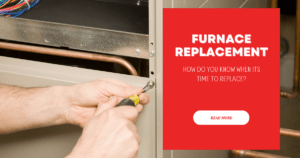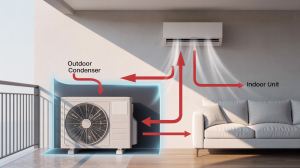We’ve compiled a checklist of ten simple steps that you can take to winterize your home before the cold winter weather. By taking the time to check these winterization tips off your to-do list, you’ll be helping ensure that your home and property are safeguarded against freezing temperatures.
Follow these tips for winterizing your home and prepare for cold weather:
1. Change Your Thermostat Settings
Adjusting your thermostat settings is an easy way to save energy during the cold weather season. This can be done easily with a programmable smart thermostat with a pre-set schedule. According to Energy.gov, the optimal temperature for inside a house in the winter is 68 degrees Fahrenheit while you are at home. If you’re looking to reduce your energy bill, consider that lowering your thermostat temperature by 7 to 10 degrees could reduce your energy bill by as much as 10%.[1] Try setting your day-time temperature to approximately 68 degrees Fahrenheit, and then adjust your temperature to 60 degrees Fahrenheit while you are sleeping. This will help ensure your furnace system isn’t working harder than it needs to!
The Sleep Foundation wrote “most doctors recommend keeping the thermostat set between 60 to 67 degrees Fahrenheit for the most comfortable sleep. Our bodies are programmed to experience a slight dip in core temperature in the evening. Turning the thermostat down at night may help with temperature regulation and signal your body that it’s time for bed.”[2] So, it’s a win-win, you’ll likely sleep better, and your heater won’t have to work as hard which helps save you money on your energy bills!
2. Have your HVAC System Checked
Be sure to have your heating system checked before the cold temperatures arrive. You don’t want to risk your furnace malfunctioning during extreme cold temperatures! By having your furnace inspected and maintained before the temperatures drop, you’ll be taking the right steps to ensure your furnace is operating safely (e.g., no gas leaks or electrical connection issues), that your HVAC system has proper airflow, and that your furnace is operating at its peak performance and efficiency. When an HVAC system is functioning at peak efficiency, you can expect to save money on energy bills. Also, catching an HVAC issue before it breaks down is a great way to prevent costly damage repairs, thereby providing you with cost savings. At Larry Cook Heating and Cooling, we inspect and service all makes and models of HVAC systems.

3. Clean Gutters
Cleaning your gutters is another important part of winterizing your home for winter, as it will prevent ice dams and allow melting snow to drain properly. If you dislike the task of cleaning gutters, consider installing gutter guards to help keep debris from entering your gutters.
4. Protect Pipes
Are your water pipes located within exterior walls? If so, consider insulating around these pipes. Another way to protect your pipes during freezing temperatures is to have water running in faucets throughout your home. This is a great way to guard against your pipes from freezing, and ultimately bursting.
5. Seal Cracks
Prevent cold air from seeping into your home by caulking around any gaps or holes often found around doors and windows. Also, the attic in a home is one of the most common places where heat escapes if it is not well sealed and insulated. Take the time to seal up your home so that your heat doesn’t escape.
6. Tend to Sidewalks and Branches
Stock up on ice-melt so you are prepared to keep your driveway and sidewalks clear of ice. In addition to icy driveways and sidewalks, ice storms often cause ice deposits to accumulate atop of braches and onto your roof. When this happens, the weight of the ice can damage shingles. Be sure to prune branches and trees that may hang over your home to prevent roof damage in the event of an icy weather event.
7. Install an Emergency Release
If you don’t have one already, install an emergency pressure release valve into your plumbing system. This valve protects against the increased pressure that is caused by freezing pipes and helps prevent water pipes from bursting. While you’re installing the emergency pressure release valve, be sure to locate your water shut off location, just in case you need to turn off your water in an emergency situation.
8. Test Smoke and Carbon Monoxide Detectors
Be sure to test your smoke and carbon monoxide detectors regularly. In fact, the Federal Emergency Management Agency (“FEMA”) recommends that nine-volt battery smoke detectors be tested monthly, that batteries be replaced annually, and that the entire smoke alarm be replaced every 10 years.[3] FEMA also recommends that carbon monoxide alarms be tested at least once a month, as carbon monoxide is the invisible killer – it’s colorless, odorless, and poisonous.[4] Smoke detectors and carbon dioxide detectors are important life-saving devices.
To test your smoke detector, locate and push the test button on your smoke detector. A few seconds after you push the test button on your smoke detector, a loud siren noise should come from the smoke detector. To test your carbon monoxide detector, locate and hold down the test button until you hear two beeps. Once you hear two beeps, release your finger from the test button. Always refer to the testing instructions provided by the smoke and carbon monoxide detector manufacturer.
Remember, smoke detectors and carbon monoxide detectors won’t work properly if debris or dust has settled into the devices. Keep them clean!
9. Fall Yard Clean-up
In the fall months, take the time to trim the trees surrounding your home and remove any dead branches or debris from your yard. Weak trees, branches, and debris can be a hazard during wind, snow, or ice storms, with potential to damage your home and vehicles.

10. Drain and Remove Water Hoses
Winterizing any outdoor water access that you have is important if you live in a climate with the potential for freezing temperatures. A great place to start is by disconnecting any water hoses that you currently have hooked up to a water spigot. This is important because by leaving a hose connected to water spigots, this could result in water in your connection freezing, which ultimately may cause plumbing damage. Once all of your hoses are disconnected, drain them of water. If you have sprayer nozzles attached to the hoses, remove the sprayer nozzles and drain any remaining water out of the sprayer nozzles.
Many exterior water faucets have their own shutoff valve. Consider shutting off the water to your exterior water faucets, then turn your outdoor water spigots on again until the water no longer trickles out. Once you’ve done this, you’ll know that your pipes do not contain water. For extra protection, place covers over your outdoor spigots to further protect from snow and freezing temperatures.
Scheduling Fall HVAC Maintenance
Don’t let the winter weather catch you off guard this winter. Protect your home by maintaining your HVAC system. The Fall season is a great time to schedule HVAC maintenance appointments. All furnaces and air conditioning systems require maintenance during their lifespan. In fact, having your HVAC system checked on a regular basis by an experienced and professional HVAC technician is essential when it comes to a long lasting heating and cooling system. If you schedule an HVAC maintenance appointment with Larry Cook Heating and Cooling, our experienced technicians will provide an HVAC system tune up and will check your entire system to make sure it is running safely and efficiently. At maintenance appointments, our technicians provide service, such as (but certainly not limited to): A/C, heater and humidifier checkup and cleaning, replace dirty filters, inspect safeties, lubricate moving parts, inspect and adjust thermostat, and more.
We offer one-time HVAC maintenance appointments, and also provide customers with the option to purchase HVAC maintenance packages for extra cost savings. Currently we offer two HVAC maintenance packages: Silver Maintenance Package and Gold Maintenance Package. In the Silver Maintenance Package, customers receive two maintenance appointments per year, priority call response, 10% discount on all parts, and free 1” filters at maintenance appointments. Whereas, our Gold Maintenance Package includes four maintenance appointments per year, top priority call response, 20% discount on all parts, and free 1” filters at maintenance appointments. Learn more about our HVAC maintenance programs here.
To schedule an HVAC maintenance appointment, call Larry Cook Heating and Cooling today at 316-322-5668!
[1] https://www.energy.gov/energysaver/programmable-thermostats
[2] https://www.sleepfoundation.org/bedroom-environment/best-temperature-for-sleep#:~:text=The%20best%20bedroom%20temperature%20for,for%20the%20most%20comfortable%20sleep.
[3] https://www.usfa.fema.gov/prevention/outreach/smoke_alarms.html#ans5
[4] https://www.usfa.fema.gov/prevention/outreach/carbon_monoxide.html







